
The Palace of Westminster is the meeting place of the Parliament of the United Kingdom and is located in London, England. It is commonly called the Houses of Parliament after the House of Commons and the House of Lords, the two legislative chambers which occupy the building. The palace is one of the centres of political life in the United Kingdom; "Westminster" has become a metonym for the UK Parliament and the British Government, and the Westminster system of government commemorates the name of the palace. The Elizabeth Tower of the palace, nicknamed Big Ben, is a landmark of London and the United Kingdom in general. The palace has been a Grade I listed building since 1970 and part of a UNESCO World Heritage Site since 1987.
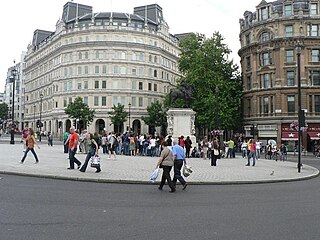
Charing Cross is a junction in Westminster, London, England, where six routes meet. Since the early 19th century, Charing Cross has been the notional "centre of London" and became the point from which distances from London are measured. Clockwise from north, the routes that meet at Charing Cross are: the east side of Trafalgar Square leading to St Martin's Place and then Charing Cross Road; the Strand leading to the City; Northumberland Avenue leading to the Thames Embankment; Whitehall leading to Parliament Square; The Mall leading to Admiralty Arch and Buckingham Palace; and two short roads leading to Pall Mall.

The Marble Arch is a 19th-century white marble-faced triumphal arch in London, England. The structure was designed by John Nash in 1827 as the state entrance to the cour d'honneur of Buckingham Palace; it stood near the site of what is today the three-bayed, central projection of the palace containing the well-known balcony. In 1851, on the initiative of architect and urban planner Decimus Burton, a one-time pupil of John Nash, the arch was relocated to its current site, near the northeast corner of Hyde Park, so that expansion of Buckingham Palace could proceed.

Parliament Square is a square at the northwest end of the Palace of Westminster in the City of Westminster in central London, England. Laid out in the 19th century, it features a large open green area in the centre with trees to its west, and it contains twelve statues of statesmen and other notable individuals.

William Behnes was a British sculptor of the early 19th century.
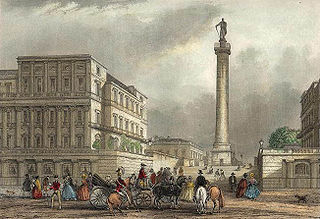
The Duke of York Column is a monument in London, England, to Prince Frederick, Duke of York, the second son of King George III. The designer was Benjamin Dean Wyatt. It is sited where a purposefully wide endpoint of Regent Street, known as Waterloo Place and Gardens, meets The Mall, between the two terraces of Carlton House Terrace and their tree-lined squares. The three very wide flights of steps down to The Mall adjoining are known as the Duke of York Steps. The column was completed in December 1832, and the statue of the Duke of York, by Sir Richard Westmacott, was raised on 10 April 1834.

Major-General Stringer Lawrence was a British military officer who served as the first Commander-in-Chief of Fort William from 1748 to 1754.
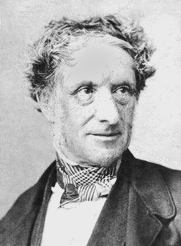
Sir Richard Westmacott was a British sculptor.
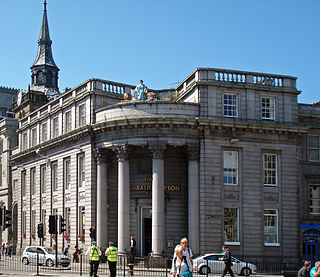
The architecture of Aberdeen, Scotland, is known for the use of granite as the principal construction material. The stone, which has been quarried in and around the city, has given Aberdeen the epithet The Granite City, or more romantically, and less commonly used, the Silver City, after the mica in the stone which sparkles in the sun.

Richard Coeur de Lion is a Grade II listed equestrian statue of the 12th-century English monarch Richard I, also known as Richard the Lionheart, who reigned from 1189 to 1199. It stands on a granite pedestal in Old Palace Yard outside the Palace of Westminster in London, facing south towards the entrance to the House of Lords. It was created by Baron Carlo Marochetti, an Italian sculptor whose works were popular with European royalty and the nobility, though often less well regarded by critics and the artistic establishment. The statue was first produced in clay and displayed at The Great Exhibition in 1851, where it was located outside the west entrance to the Crystal Palace. It was well received at the time and two years later Queen Victoria and Prince Albert headed a list of illustrious subscribers to a fund that aimed to raise money for the casting of the statue in bronze.

Nelson Mandela is a bronze sculpture in Parliament Square, London, of former President of South Africa and anti-apartheid activist Nelson Mandela. Originally proposed to Mandela by Donald Woods in 2001, a fund was set up and led by Woods's wife and Richard Attenborough after the death of Woods. The then Mayor of London Ken Livingstone obtained permission from Westminster City Council to locate the statue on the north terrace of Trafalgar Square, but after an appeal it was located in Parliament Square instead where it was unveiled on 29 August 2007.
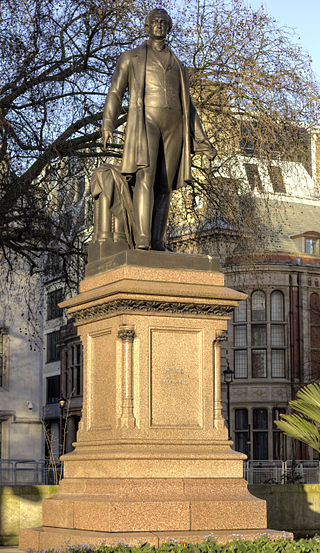
The statue of Robert Peel in Parliament Square, London, is a bronze sculpture of Sir Robert Peel, a former prime minister of the United Kingdom. It was sculpted by Matthew Noble and was one of the first three statues to be placed in the square.
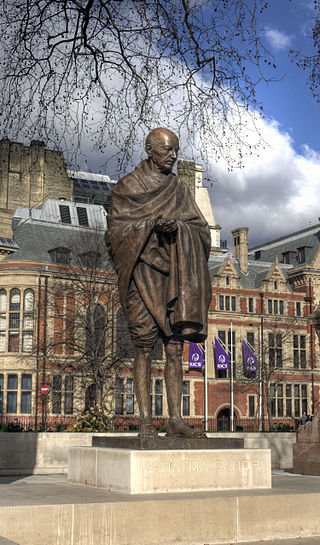
The statue of Mahatma Gandhi in Parliament Square, Westminster, London, is a work by the sculptor Philip Jackson.

A bronze statue of Isambard Kingdom Brunel, also known as Brunel Monument or the Isambard Brunel Monument, by Carlo Marochetti, stands on the Victoria Embankment in London, England, at the west end of Temple Place. The statue rests on a Portland stone pedestal, with flanking screens and benches, by the architect Richard Norman Shaw.
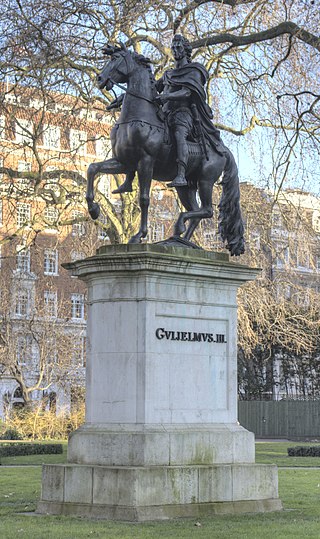
The equestrian statue of William III by John Bacon Junior stands in St James's Square in central London. It is modelled on an earlier statue of the king by John Michael Rysbrack in Queen Square, Bristol. Funding for the London statue was provided in the will of Samuel Travers, M.P., dated 1724, but nothing was done to progress the plan for a further seventy years. A design for the monument was drawn up in 1794 by Bacon's father, John Bacon Senior, but this was not executed and the commission passed to Bacon Jr., under whose direction the statue was finally erected in 1808. The statue is a Grade I listed structure.

The statue of Millicent Fawcett in Parliament Square, London, honours the British suffragist leader and social campaigner Dame Millicent Fawcett. It was made in 2018 by Gillian Wearing. Following a campaign and petition by the activist Caroline Criado Perez, the statue's creation was endorsed by both the Prime Minister of the United Kingdom, Theresa May, and the Mayor of London, Sadiq Khan. The statue, Parliament Square's first monument to a woman and also its first sculpture by a woman, was funded through the government's Centenary Fund, which marks 100 years since some women won the right to vote. The memorial was unveiled on 24 April 2018.

The statue of Charles James Fox stands at the north end of Bloomsbury Square in the London borough of Camden. Erected in 1816, the sculptor was Richard Westmacott. It commemorates the Whig politician who died in 1806. Fox is shown in the garb of a Roman senator. The statue is a Grade II* listed structure.

A bronze statue of Robert Stephenson by Carlo Marochetti usually stands on a red granite plinth in the forecourt of Euston railway station in London, England. Erected in 1871, it is one of few surviving elements of the original station after it was redeveloped in the 1960s, and it became a Grade II listed building in 1974. It was temporarily removed in 2020 to allow the station to be remodelled to accommodate the new High Speed 2 (HS2) railway line.

The Gladstone Memorial on the Strand, London is a bronze sculpture of the British statesman, created by Hamo Thornycroft between 1899-1905. The statue was erected as the national memorial to Gladstone and shows him in the robes of the Chancellor of the Exchequer. The figure stands on a plinth surrounded by allegorical figures depicting four of the Virtues, Courage, Brotherhood, Education and Aspiration. The memorial is a Grade II listed structure.

The statue of Alfred the Great in Southwark is thought to be London's oldest outdoor statue. The lower portion comes from a Roman statue dating to the late 1st or early 2nd century AD, while the top portion is a late 18th- or early 19th-century Coade stone addition in medieval style.






















